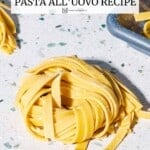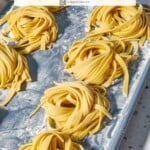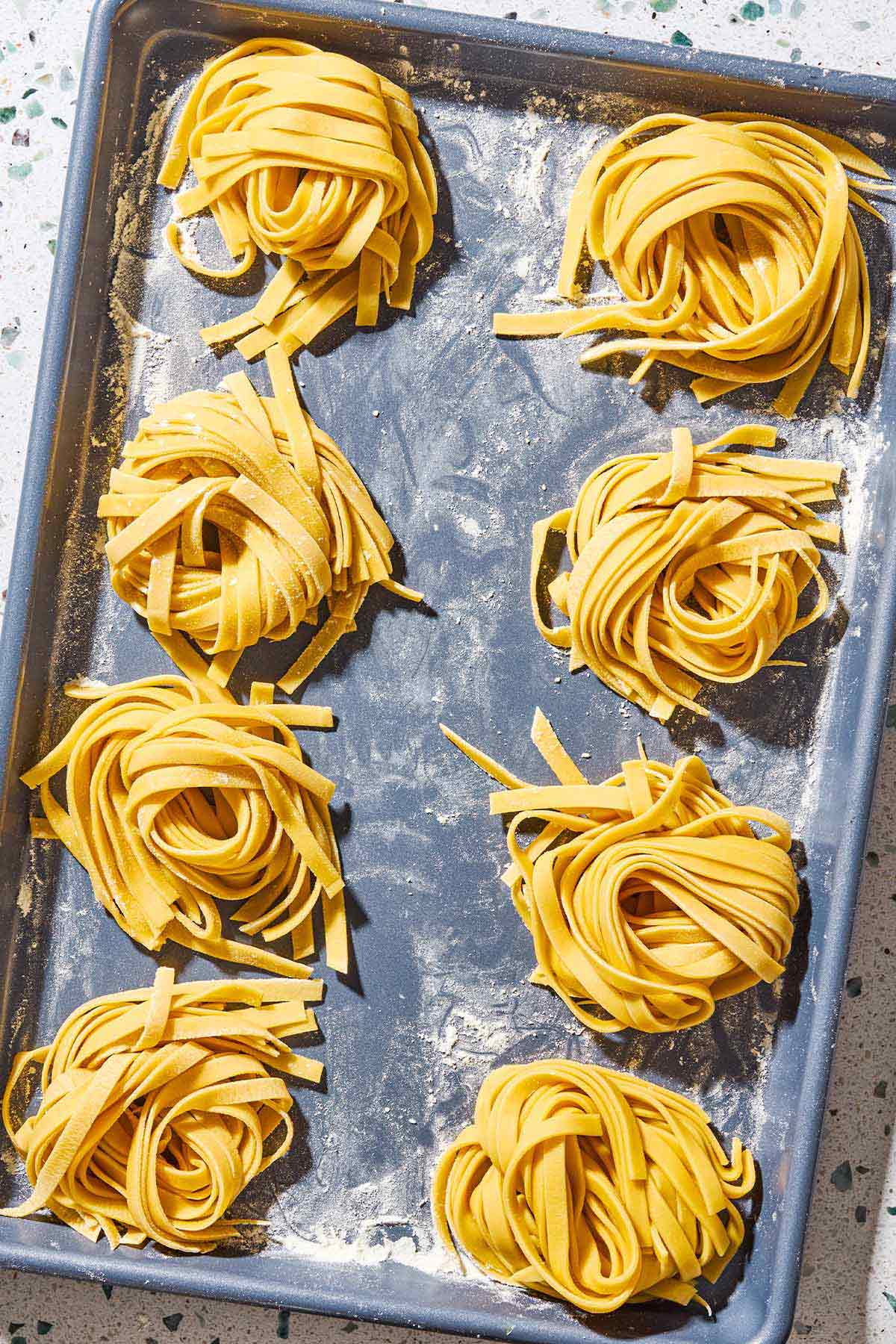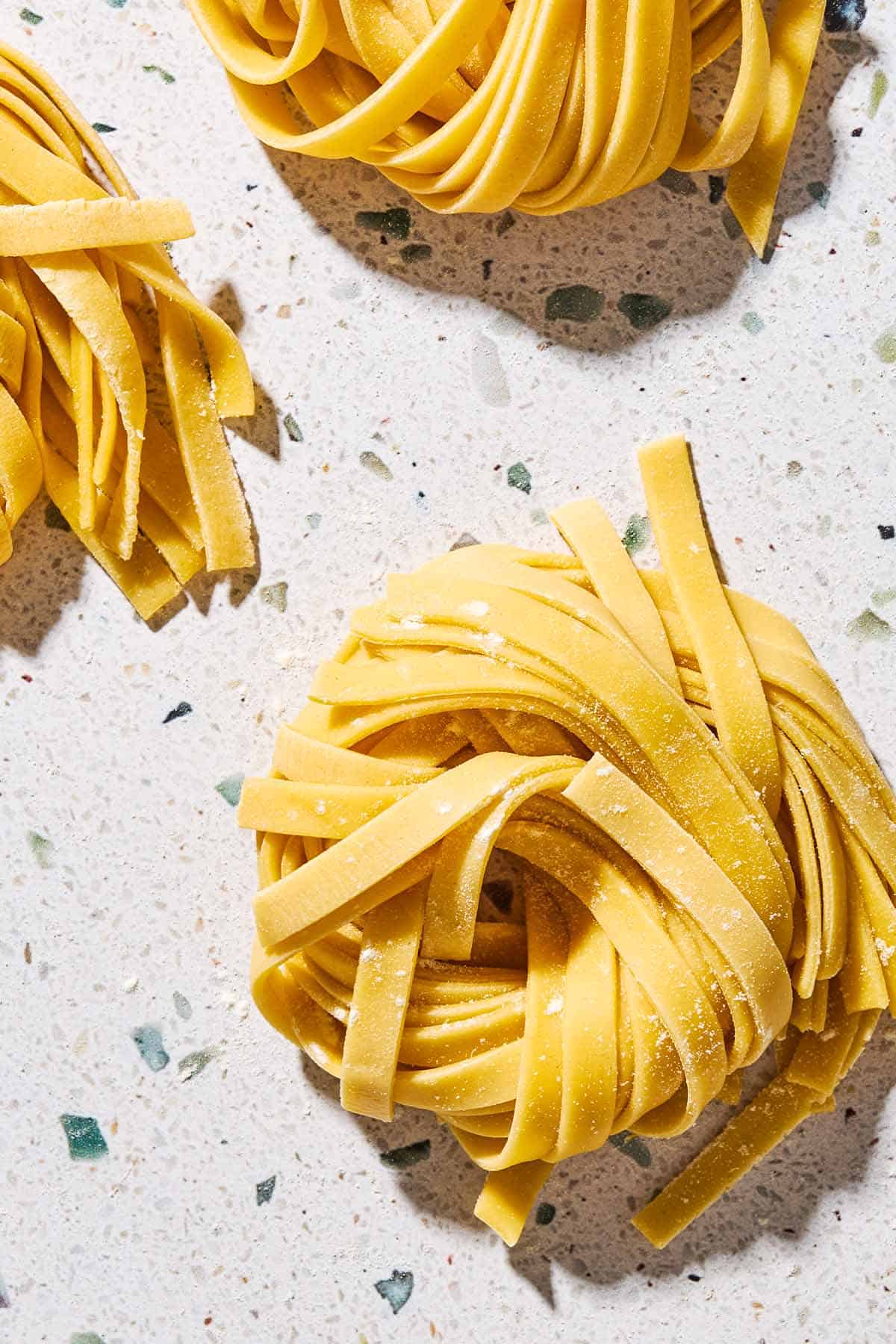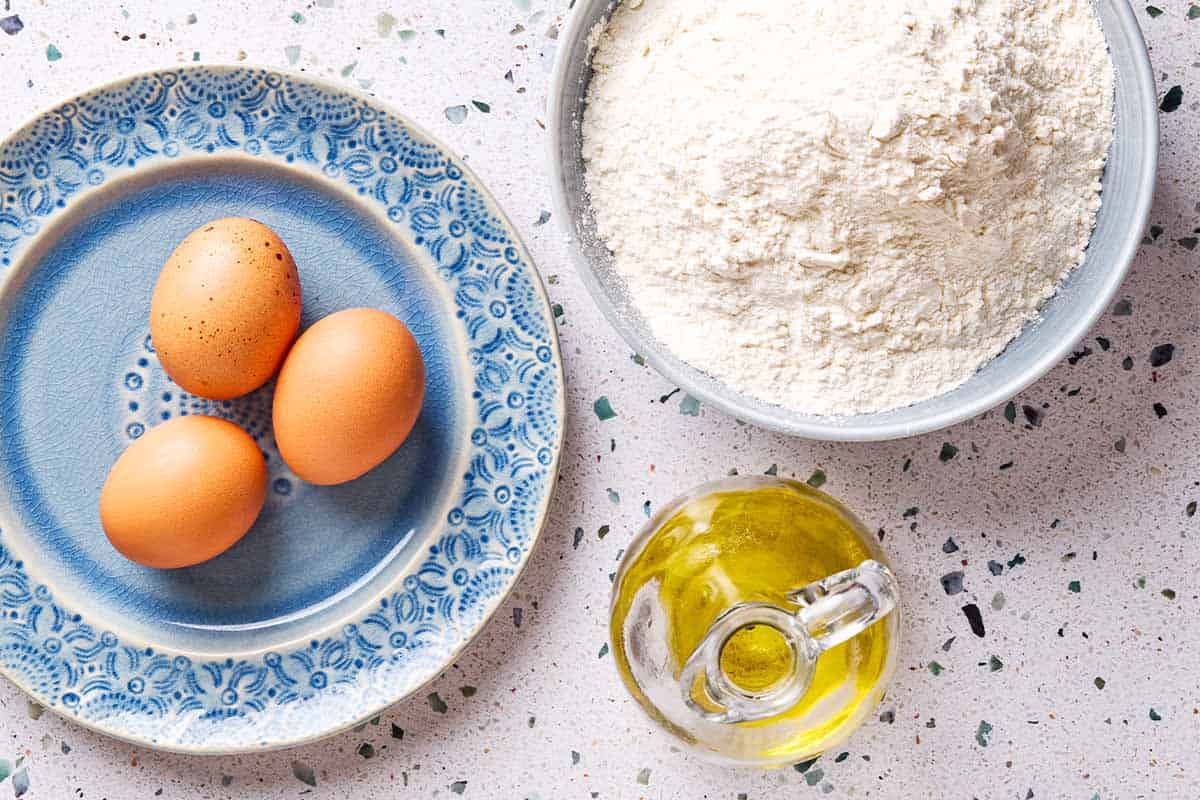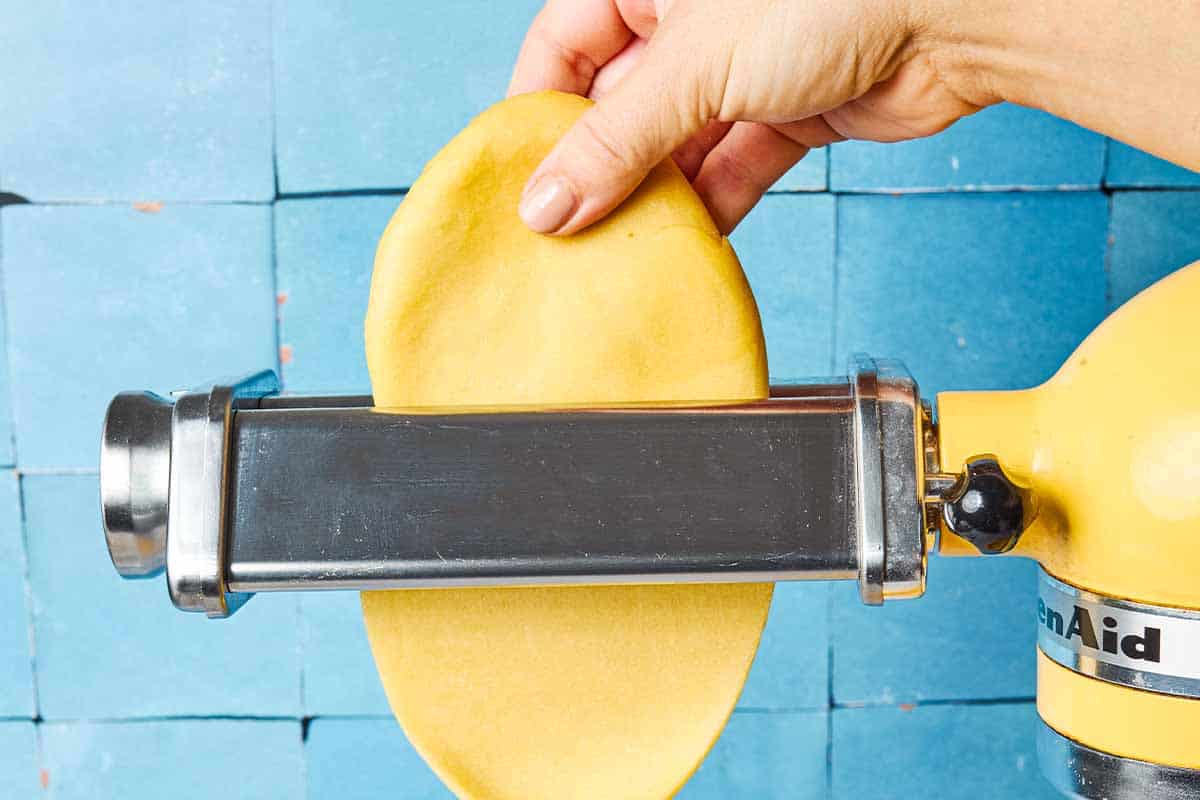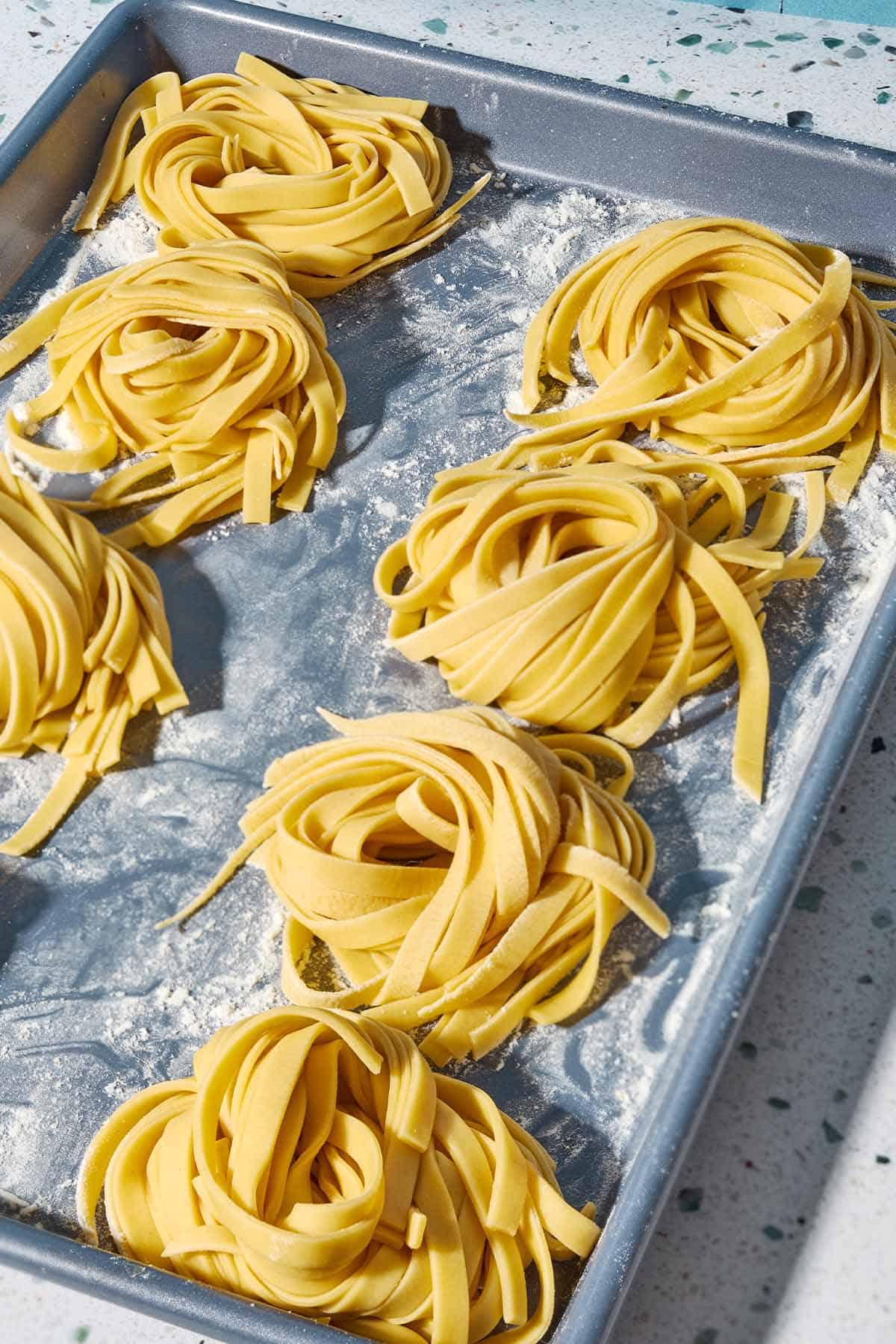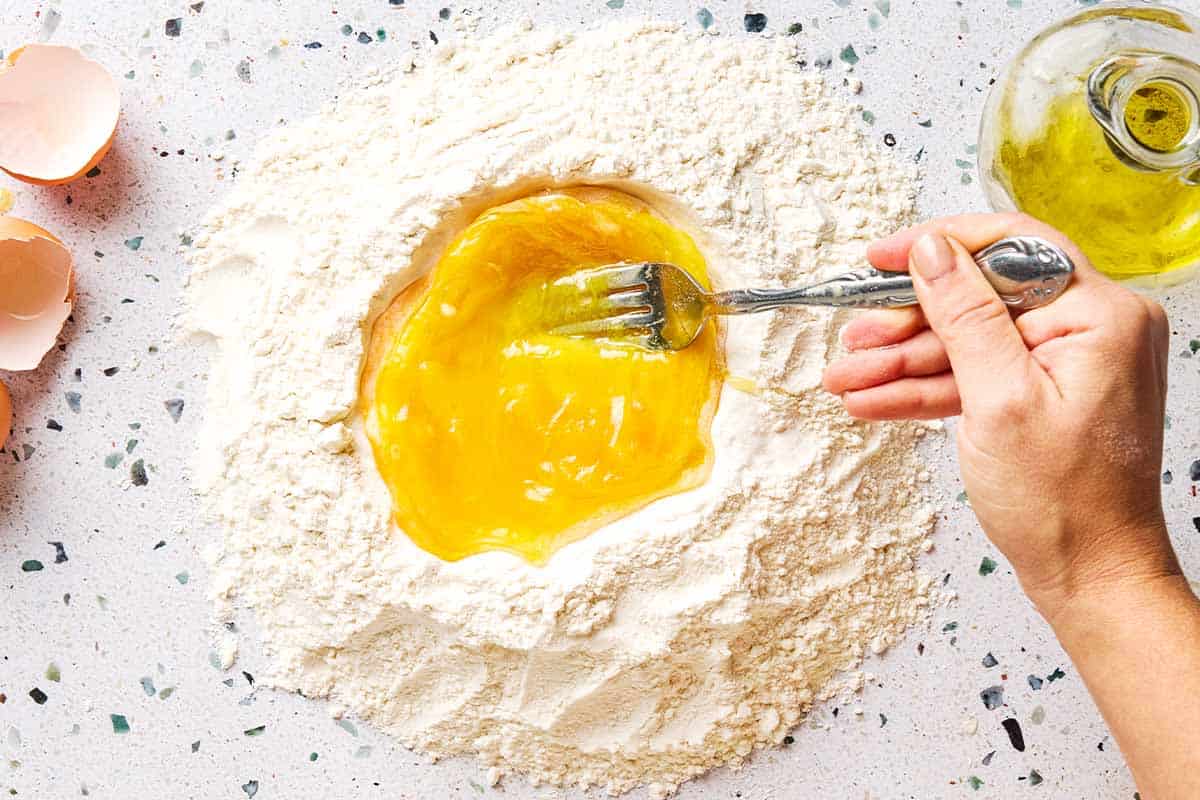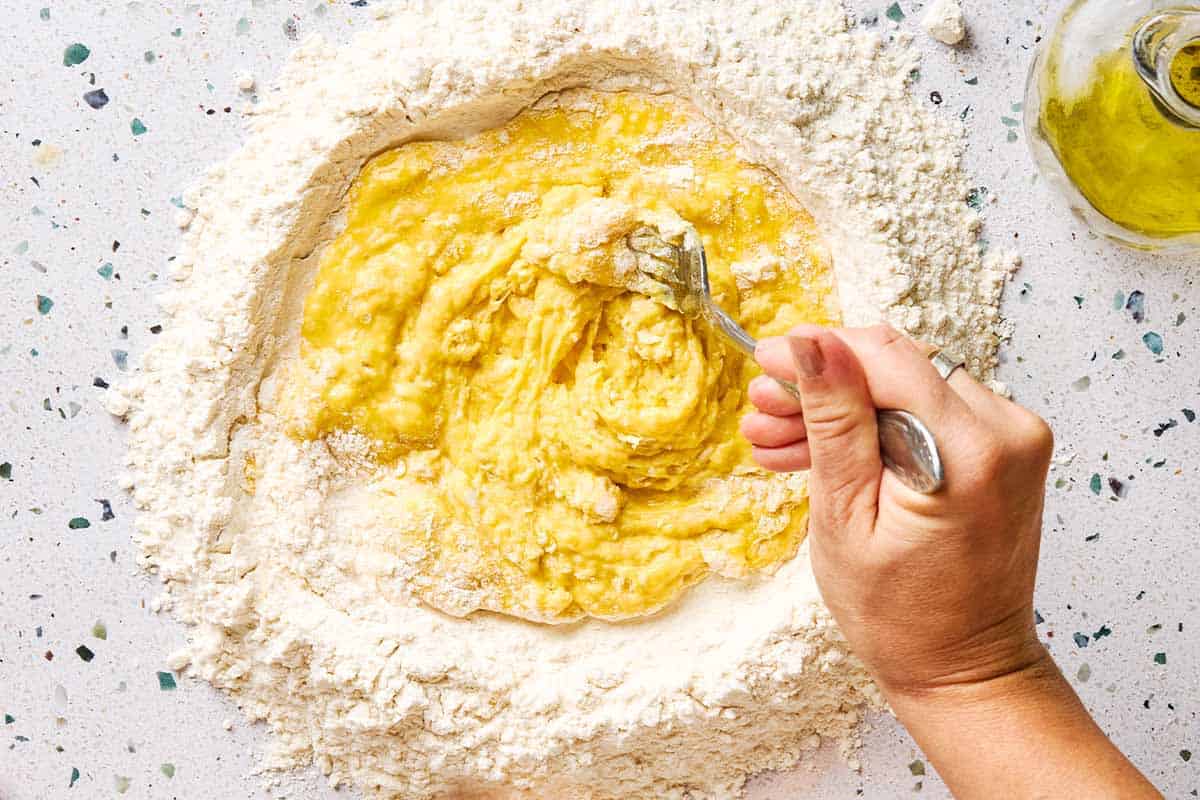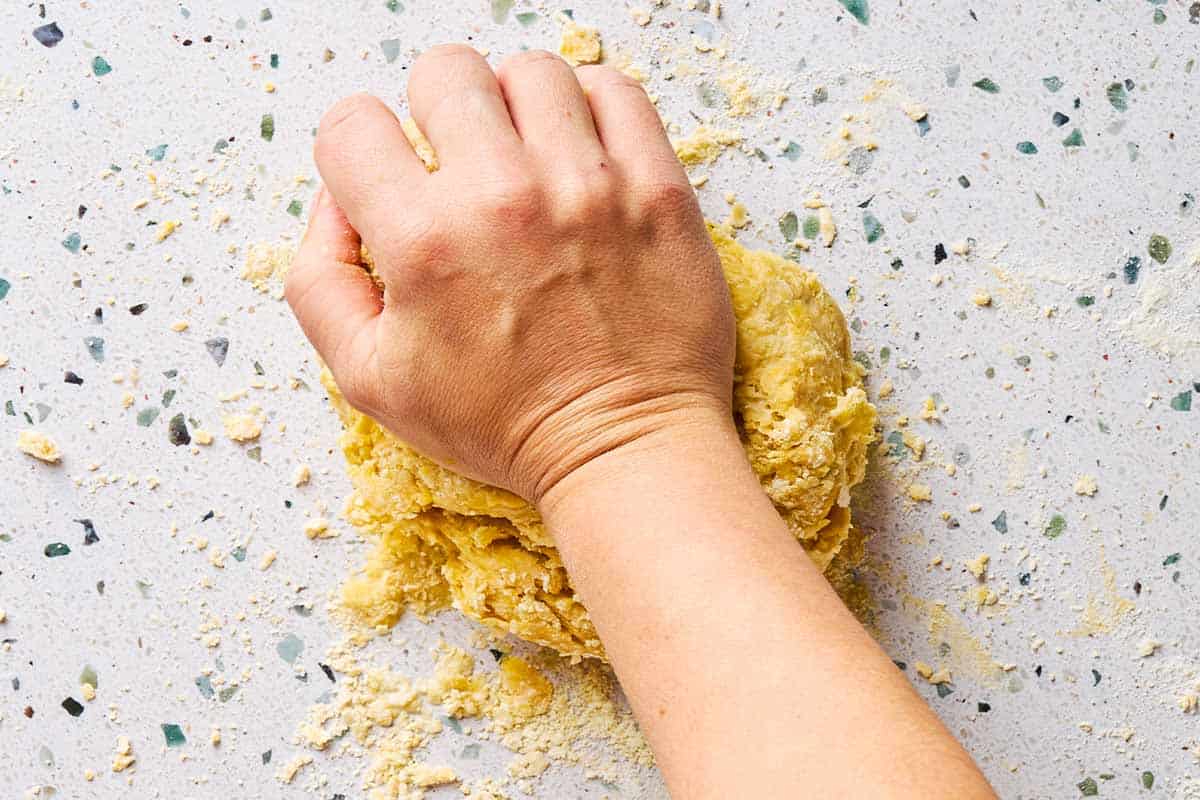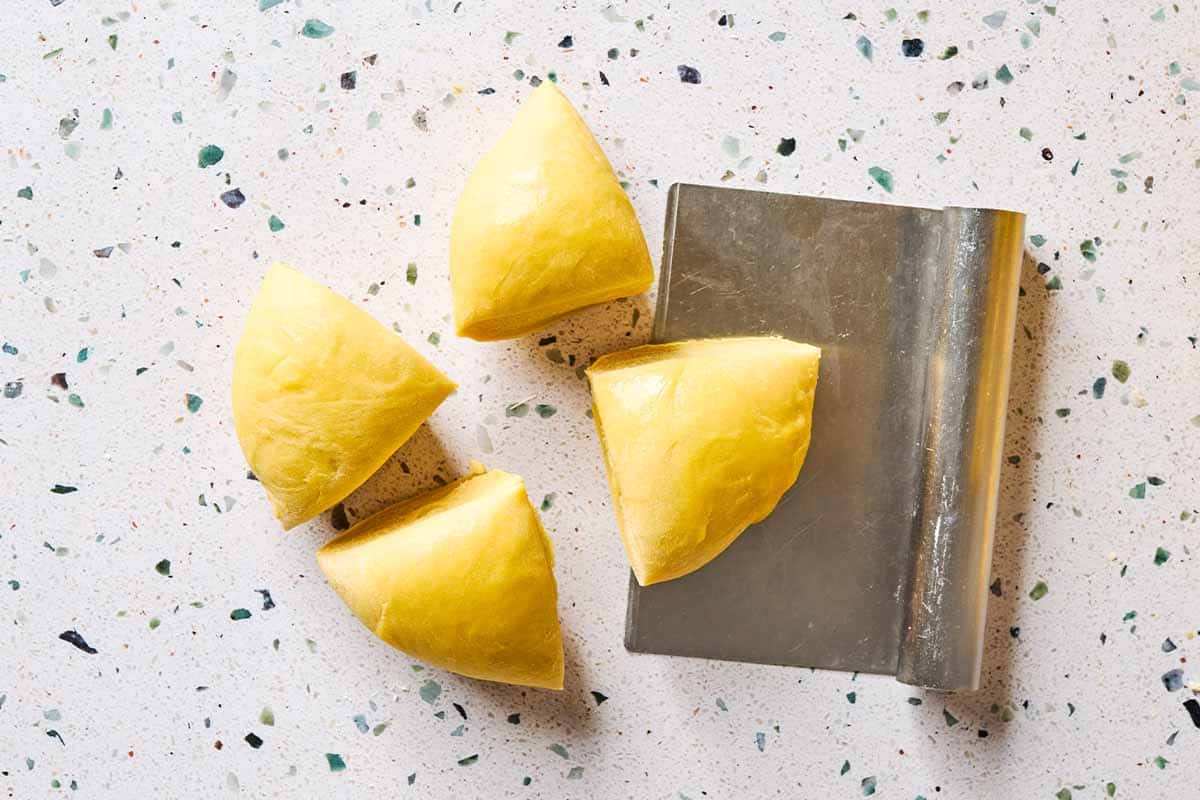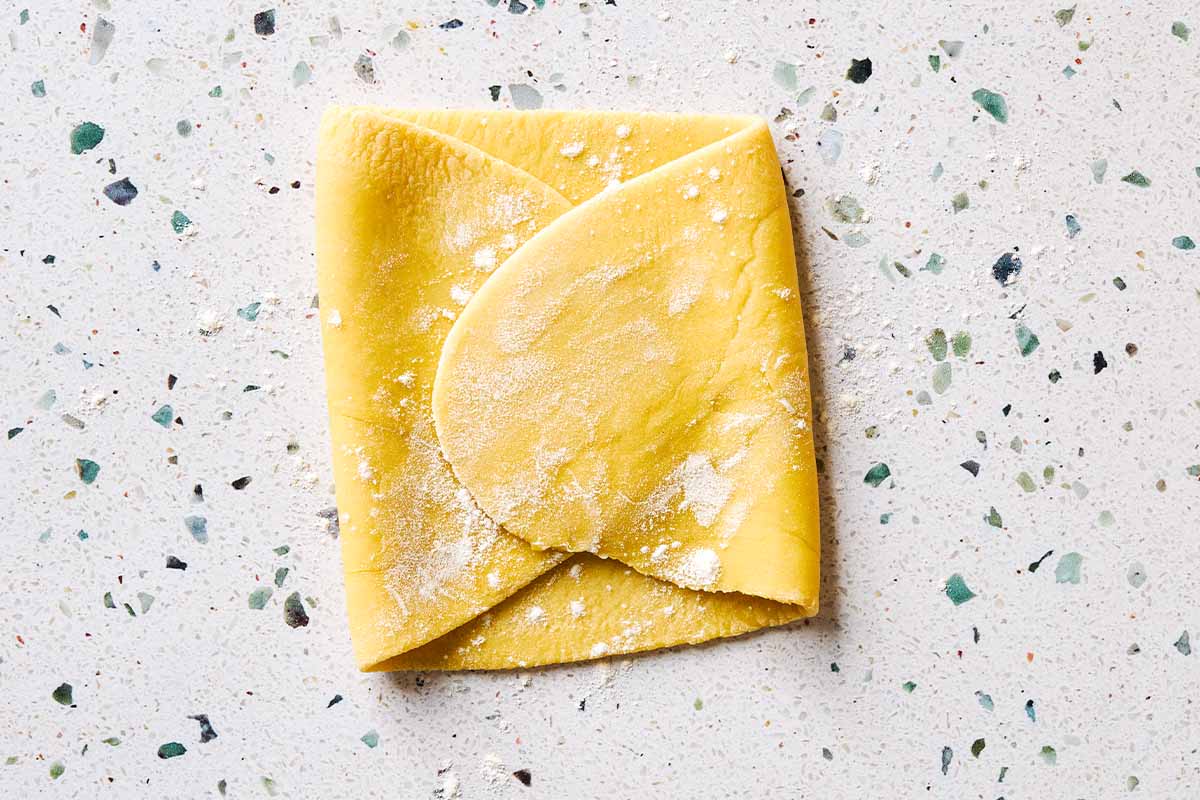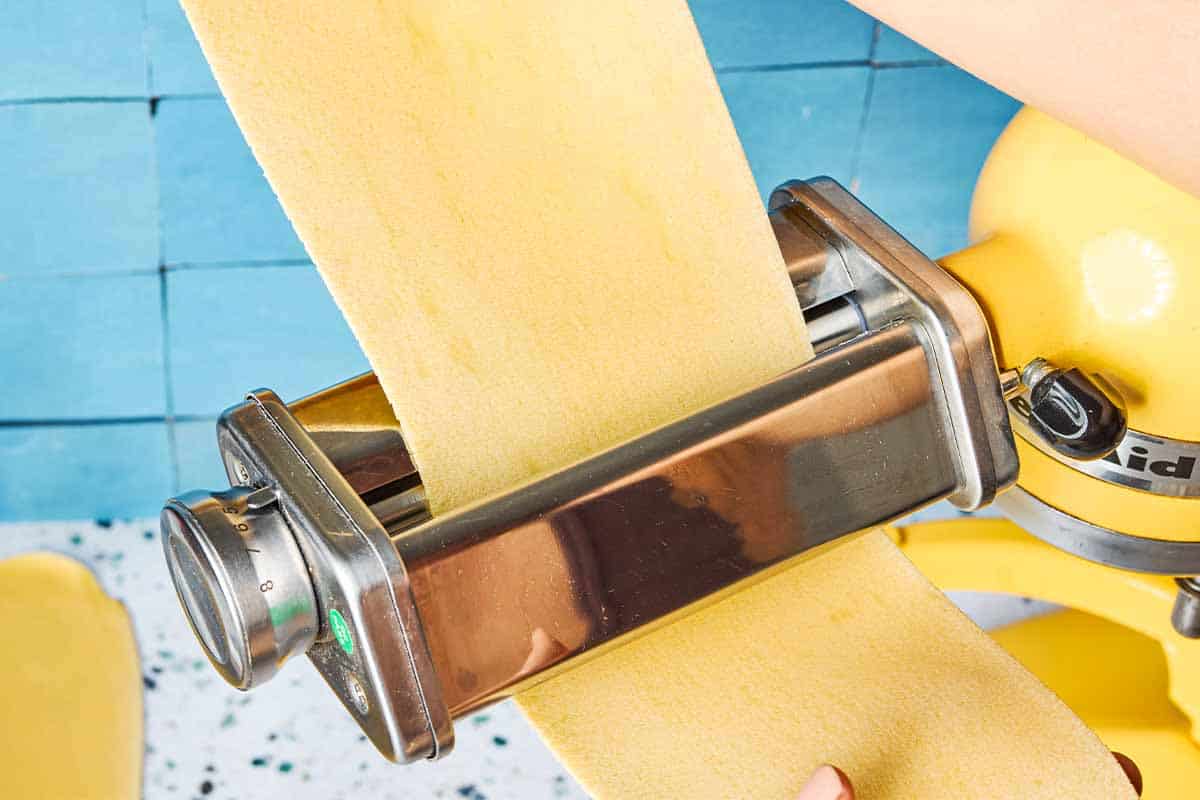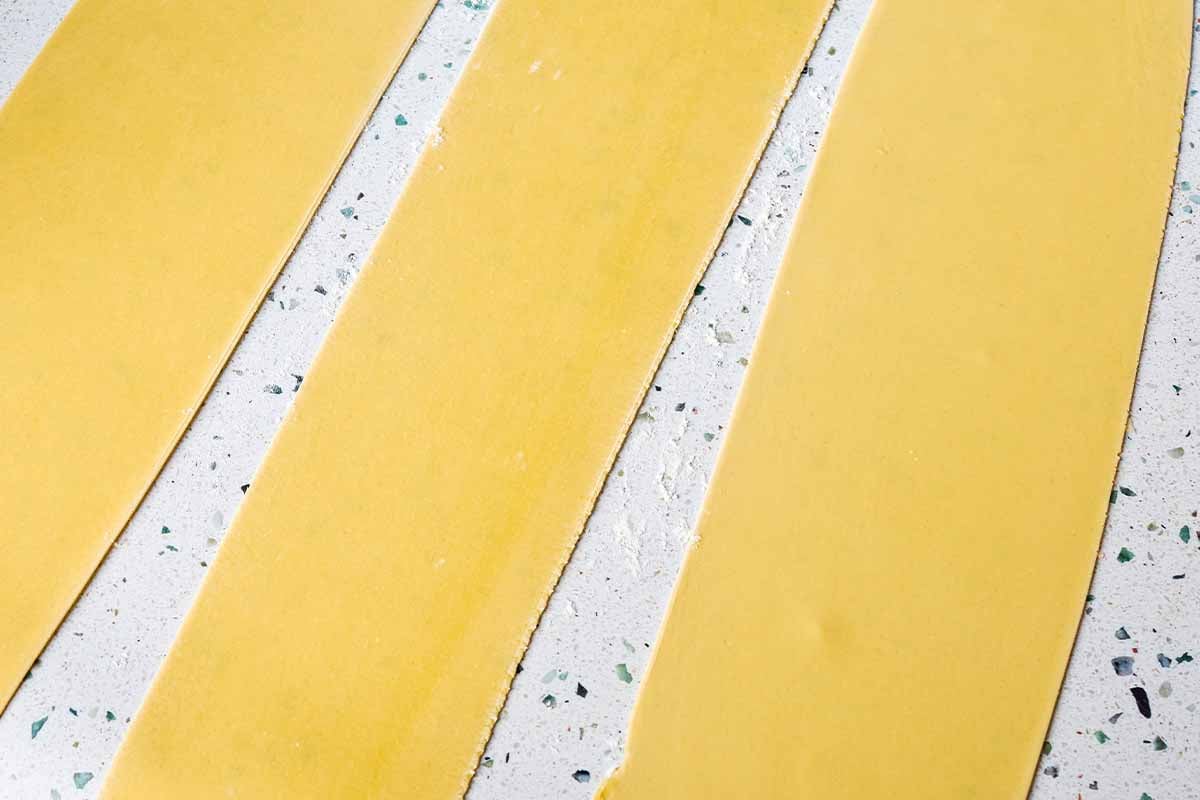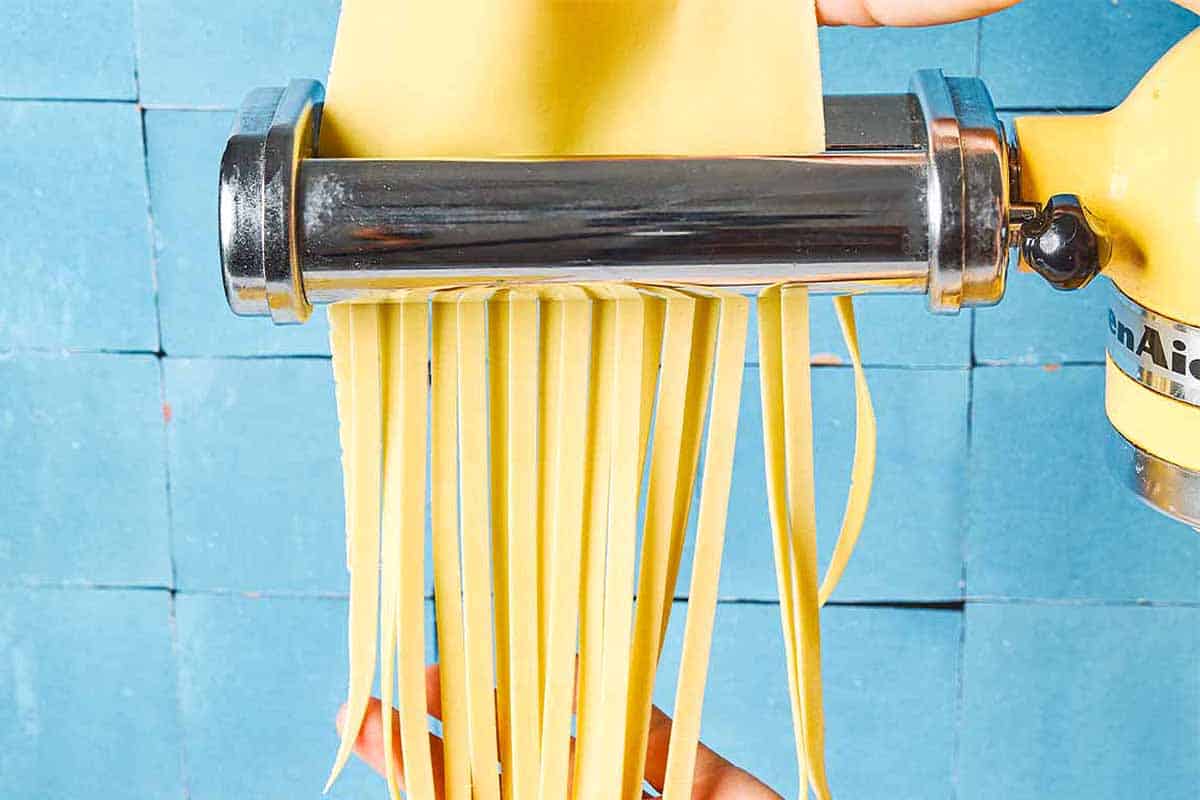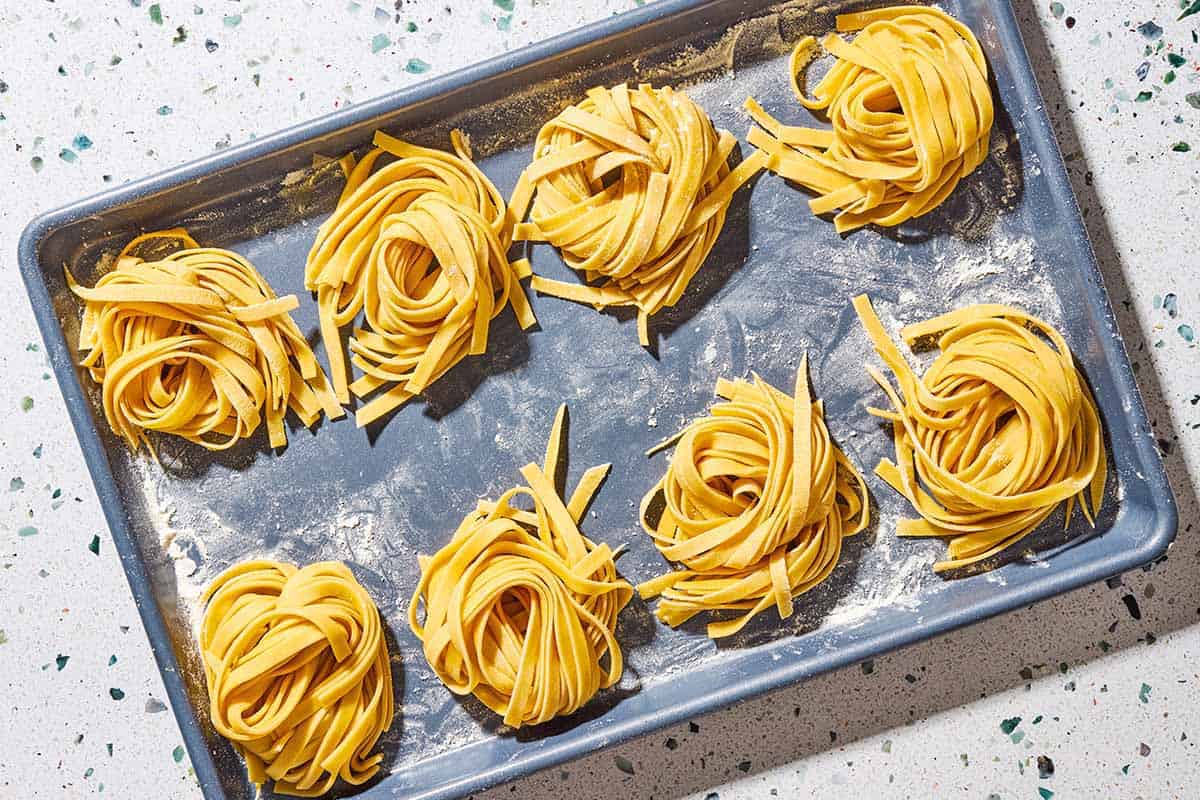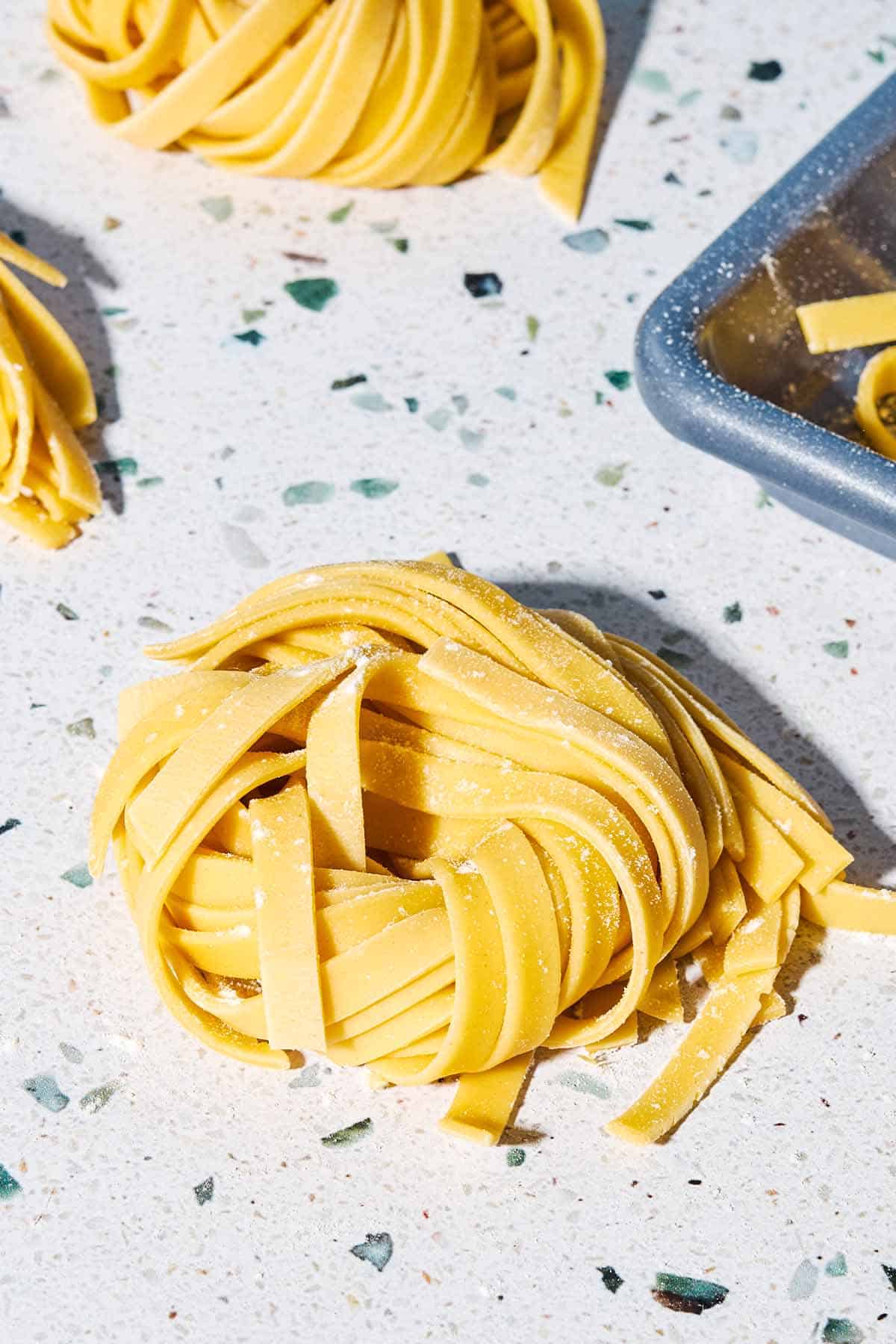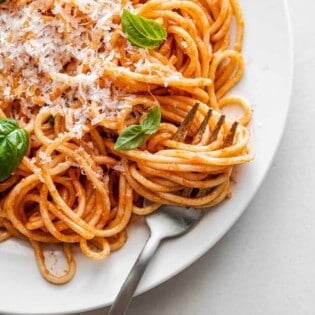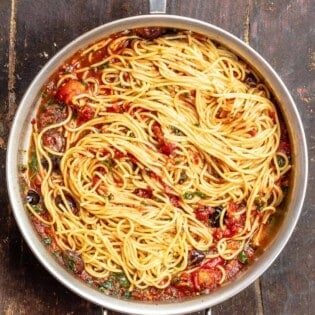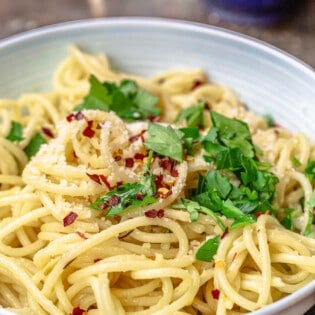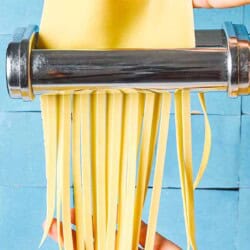My Italian mother made homemade pasta often. She cut her smooth egg-rich dough into a variety of shapes, but among my favorites were her fettuccine—silky flat noodles. She served her homemade noodles with a traditional Bolognese Ragù or, sometimes, simple Pomodoro Sauce. I still remember her hanging the freshly cut noodles to dry on a broomstick that she positioned between two chairs. There was nothing better than sitting down to a dish of homemade pasta on a Sunday evening, twirling the long noodles on my fork, and taking that first, much-anticipated bite. I still love making homemade pasta on Sundays, and my mom’s recipe remains the template I use to make my own homemade egg pasta. If you’ve never made pasta from scratch, you’ll be surprised at how easy it is once you get the hang of it. What’s more, it is truly an enjoyable pursuit, for date nights, sunday nights in, kid’s activities, and more. After years of doing it, I still get a feeling of great satisfaction when I look at a batch of freshly cut pasta that I made myself. Why don’t you join me? Let’s get started.
The Basics: Is Fresh Pasta Better than Dried?
People often ask me if homemade pasta is better than the dried pasta you buy at the supermarket. Here’s my answer: Dried pasta and fresh pasta are two different things. Comparing them really is like comparing apples to oranges; one is not better than the other. Both have their place in the Italian kitchen. Most commercial dried pasta is made from a mix of durum wheat (semolina) flour and water; there is no egg. The best brands slowly dry the pasta over a period of about two days before packaging it. When you cook it properly to “al dente” doneness, dried pasta has an appealing toothsome texture and a light, toasty wheat flavor. You can make fresh pasta with the same ingredients as boxed pasta, which yields a sturdy pasta that works well for shapes like cavatelli and orecchiette. For more delicate noodles like fettuccine, egg pasta is best. Egg pasta is typically made with “softer,” more finely milled flour. Other pasta shapes made with egg dough are for stuffed pastas, like ravioli and lasagne sheets. You can find high-quality egg pasta at gourmet food shops and some supermarkets. But why not make your own? It’s easy, economical, and you probably have the ingredients on hand.
READ MORE: The Complete Guide to Italian Pasta Shapes and the Sauces that Love Them
Homemade Pasta Ingredients
You really only need two ingredients to make homemade egg pasta: Flour and eggs. However, I add just a drizzle of olive oil to my homemade noodles to give it extra silkiness. This is something my mom did. In my opinion, it improves the flavor and texture of the dough. I used to salt my pasta dough but I’ve learned this is unnecessary, as the pasta absorbs salt and flavor when it cooks in salted boiling water.
The Best Flour For Homemade Pasta
You might have read that “00” or “double zero flour” is the best flour for homemade pasta. This is a soft wheat flour that can be milled to a very fine, powdery consistency. It is what most cooks use when making egg pasta in Italy. It yields soft, silky, stretchy dough ideal for noodles, ravioli, and other delicate pasta. You don’t need to make a special trip to the store to buy “00” flour. The unbleached all-purpose flour in your pantry makes excellent pasta. It’s slightly sturdier than pasta made with “00” flour, and it produces a satisfying result that is both tender and chewy. It’s what I use most of the time when I make pasta at home. You can also use a mix of all-purpose flour and 00 flour. I often add just a tablespoon or two of semolina flour to my egg pasta dough. This adds an extra bit of texture, which I like. But it’s really up to you. Once you’ve made pasta a few times, you’ll start to get a feel and a taste for your preferences.
The Function of Eggs and Olive Oil in Pasta Dough
Eggs add the liquid to turn the flour into pasta dough. The whites contribute elasticity, and the yolks provide richness. The general flour-to-egg ratio is one egg per every 100 grams of flour, but it’s not a precise measurement. Eggs come in different sizes. Some have large yolks, some have more whites. Flour is also a variable ingredient. Different flours absorb slightly different amounts of liquid, depending on the type of wheat, the age of the flour, and even the humidity or moisture in the air. Just a splash of extra virgin olive oil—about 1 tablespoon—gives pasta dough added richness and smoothness and enhances its flavor. Buttery-smooth Italian Nocellara Extra Virgin Olive Oil is a great choice for this recipe.
Equipment for Making Fresh Pasta
You can make this fresh pasta recipe without specialty equipment, but there are a few tools that will make the process faster and easier. Here’s what I recommend:
For Rolling and Cutting the Dough
Pasta machine: I highly recommend using a pasta machine to stretch the dough. I use a classic hand crank machine with rollers to stretch the dough into sheets, as well as cutters to cut the sheets into ribbons. Stand mixer pasta attachment: Uses the mixer’s motor to propel the dough through the attachment rollers. You’ll need both the roller attachment and a cutter attachment to cut the sheets of dough into fettuccine, spaghetti, or whatever noodle you prefer. You can often find them sold together. Rolling pin: Use a long, straight wooden pin. I think it’s worth investing in a pasta-specific one if you’re hand-rolling pasta since you’ll need such long, wide sheets. Note: This technique takes a fair amount of practice and elbow grease to get the dough perfectly thin and even. I don’t recommend it for novices. If you’d like to give it a shot, divide the dough into 3 before rolling. Or, if you don’t have the machinery but still want to make homemade pasta, consider starting with Ricotta Gnocchi.
Other Optional–But Handy–Equipment
Dough scraper: I use a dough scraper to scoop up flour and bits of dough. I also use it to help incorporate the eggs into the flour without getting my hands sticky. Rimmed baking sheet: After I’ve cut my homemade noodles, I form them into nests and place them on a floured baking sheet to rest. This prevents the noodles from sticking or clumping together. Wooden board: Pasta dough responds to warmth. Unlike pie or biscuit dough, which are best mixed on a “cool” surface like marble and should only be briefly kneaded, pasta dough is best mixed on a “warm” surface like wood, and it’s almost impossible to over-knead it. You can use an extra large cutting board, or invest in a pasta board with a lip that fits against the countertop to prevent it from sliding. Digital scale: Measuring flour with a digital scale is more precise than using volume measurements (cups). If you have a scale, use it to weigh your flour. Otherwise, lightly spoon the flour into the measuring cup until slightly mounded, then sweep off the excess with the flat side of a knife or a dough scraper. Spray bottle: If you end up with dry ball of dough, you may need to add a little water to make it more supple. I find that spritzing water with a spray bottle onto the dough and then kneading it in is the easiest way to incorporate it.
How to Make Homemade Pasta
Ready to roll up your sleeves and make fresh pasta? Follow this easy, step-by-step homemade pasta recipe and enjoy the process as you go. Even if it doesn’t turn out perfectly the first time, it will still be delicious, and your technique will improve each time you do it.
Make and Rest Fresh Pasta Dough
Start with the flour: Measure by weighing the flour to 300 grams, or by spooning it lightly into a measuring cup, then sweeping off the excess. You’ll need about 2 1/4 cups. Mound the flour onto a clean work surface. Use the back of your hand or the bottom of a bowl to create a wide, shallow well in the mound. The “walls” of the mound should be just high enough to keep the eggs in the well. Add 3 extra large eggs to the well. Make sure the eggs are at room temperature. If they are cold, place them in a bowl of hot water for about 5 minutes to warm up. Then, crack them into the well and use a fork to beat them lightly but thoroughly with a fork. Whisk in 1 tablespoon of extra virgin olive oil. Begin incorporating the flour: Begin adding flour into the eggs by pulling it, little by little, from the inside walls of the mound. Form a shaggy dough. Continue to incorporate until the mixture is like a thick batter, then a rough, sticky dough. Use a dough scraper to help scrape up any shaggy bits from the work surface and to incorporate the flour into the eggs. Switch to your hands and begin kneading the dough together. Knead the dough: Keep kneading until you have incorporated most, or all of the flour and the dough has a nice, firm, bouncy consistency (like a baby’s bottom!). If the dough feels sticky, knead in more flour until it is firm and only slightly tacky. If it feels dry, moisten your hands with a little bit of water or spritz the dough with a spray bottle and knead it into the dough. Continue to knead for 5 to 10 minutes, until the dough is smooth, firm, and supple. If you press your finger into the dough, it should spring back, though you should still see an imprint. Cover the dough with plastic wrap or a bowl and let it rest for 1 hour.
Stretch the Pasta Dough
Prep the area to stretch the dough: Set up your pasta machine or mixer with the pasta attachment, making sure the pasta roller is at its widest setting (#1 on my hand-crank machine). Sprinkle a little flour on a cleared area around the machine or mixer. Also, sprinkle a clean rimmed baking sheet with flour. This is where you will put your noodles once you’ve cut them. Divide the dough. Cut the ball of dough into 4 quarters and rewrap three. Knead the remaining piece briefly on the work surface. With a rolling pin or the heel of your hand, flatten the piece of dough into a thick oval 3 to 4-inches long. Begin to stretch the dough. Feed the dough through the pasta machine and then lay it on the work surface. Fold the dough into thirds, as though you were folding a business letter. Sprinkle lightly with flour and pass it through the rollers again. Repeat the folding and rolling process one or two more times to help set the rectangular shape of the dough. Keep stretching. Move the roller setting to the next narrower notch and feed the strip of dough through the setting twice, sprinkling it with a little flour if needed to keep it from sticking. Continue to pass the dough through the rollers twice on each setting until you have stretched it to the desired thickness. For spaghetti or fettuccine, the dough should be between 1/8 and 1/16-inch thick. I usually stop after two passes on #5 on my hand-crank machine. The sheet should just be thin enough to see the shadow of your hand through it. Set the sheet aside on a floured surface—either your countertop or a clean tablecloth sprinkled with flour. Repeat and let dry. Stretch the remaining three pieces of dough in the same way and set them aside on a floured surface. Freshly rolled-out pasta dough is often too moist to cut immediately. For best results and to prevent noodles from sticking, let the sheets of dough dry slightly—anywhere from 10 to 20 minutes—before cutting. They are ready to cut when they are still pliable and slightly moist, but not tacky. Don’t let them over-dry or they might crack when you cut them.
Cut and Cook (or Freeze) the Homemade Pasta
Cut the pasta into noodles. Once the pasta sheets are ready, run them, one at a time, through the cutter attachment of your pasta machine or mixer. Gently wrap the noodles around your hand to form a nest and place it on the floured baking sheet. If you find the sheets are too long and unwieldy to run comfortably through the cutters, cut them in half crosswise and run each half through separately. Spaghetti and fettuccine should be about 10 to 11 inches in length. Cook and serve (or store, see “Getting Ahead” below). Bring a pot of water to a boil over high heat and salt it generously. Add the pasta and cook anywhere from 3 to 5 minutes, depending on thickness. Fresh pasta cooks quickly so take care not to overcook. Toss with your favorite sauce and enjoy.
Best Sauce for Homemade Pasta
Homemade noodles have a delicate, slightly nutty flavor and a light, bouncy texture. They pair well with a great variety of sauces, from a simple Pomodoro Sauce to zesty Puttanesca to a rich meaty ragù. I also love homemade pasta with Aglio e Olio or a seafood-based sauce like the sauce in our garlicky Shrimp Linguine—just substitute homemade noodles for the boxed linguine.
Getting Ahead: How to Store Fresh Pasta Dough
I like to make a batch of homemade pasta dough ahead of time. This way when I want to serve homemade pasta, all I have to do is cook it. I’ve found that the best way to store homemade noodles is to freeze them. To store homemade pasta:
Pop the baking sheet with pasta nests into the freezer and freeze until they are stiff. Once frozen, transfer the pasta to a container with a tight-fitting lid and place it in the freezer. Stored this way, pasta will last for up to 1 month. To cook, transfer the pasta directly from the freezer to a pot of boiling water—no need to defrost it first; in fact, defrosting it will cause the noodles to stick together. Cook until al dente—it may take an extra minute or two to fully cook frozen pasta. Toss with sauce and serve.
Browse all Mediterranean recipes.
Pasta Pomodoro (Spaghetti with Tomato Sauce)
Easy Pasta Puttanesca Recipe
Spaghetti Aglio e Olio
Shrimp Linguine
Visit Our Shop.
Hand-picked and cold extracted Extra Virgin Olive Oil from 100% Nocellara del Belice Sicilian olives.
